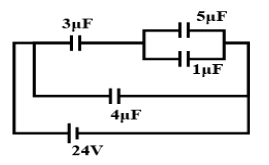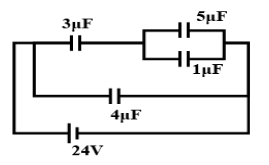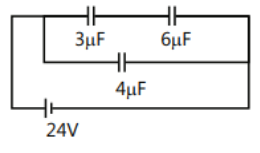
In the circuit shown, find the energy stored in \[1\mu F\] capacitor.


Answer
503.4k+ views
Hint: The ratio of the amount of electric charge deposited on a conductor to the difference in electric potential is known as capacitance. Self capacitance and reciprocal capacitance are two closely related concepts of capacitance. Self capacitance is a property of any material that can be electrically charged.
Complete step by step answer:
As capacitors are coupled in series, the overall capacitance is lower than the individual capacitances of the series capacitors. As two or more capacitors are connected in order, the result is a single (equivalent) capacitor with the cumulative total of the individual capacitors' plate spacings.
$\dfrac{1}{{{C_s}}} = \dfrac{1}{{{C_1}}} + \dfrac{1}{{{C_2}}}$
${C_p} = {C_1} + {C_2}$

Here $5\mu F + 1\mu F = 6\mu F$(Since they are in parallel and Capacitance in parallel = ${C_p} = {C_1} + {C_2}$)
Hence the circuit becomes

Here,
$\dfrac{1}{{{C_s}}} = \dfrac{1}{3}\mu F + \dfrac{1}{6}\mu F \\
\Rightarrow \dfrac{1}{{{C_s}}}= \dfrac{3}{6}\mu F \\
\Rightarrow \dfrac{1}{{{C_s}}}= \dfrac{1}{2}\mu F$
(Since they are in series and Capacitance in series = $\dfrac{1}{{{C_s}}} = \dfrac{1}{{{C_1}}} + \dfrac{1}{{{C_2}}}$)
Hence, ${C_s} = 2\mu F$
Now $2\mu F\& 4\mu F$are in parallel.
Using ${C_p} = {C_1} + {C_2}$
${C_{net}} = 2 + {\text{ 4 = 6}}\mu {\text{F }}$
We know that
$q = CV$
Where $q$ = charge, $C$ = capacitance and $V$ = Volt.
So, substituting the values we get,
$Q = 6\mu F \times 24 = 144\mu C$
$144\mu C$ is getting divided between $2\mu F\& 4\mu F$. Hence,
$\dfrac{{{q_1}}}{4} = \dfrac{{{q_2}}}{2} \\
\Rightarrow {q_1} = 2{q_2}$
$ \Rightarrow {{\text{q}}_2} = \dfrac{{144\mu {\text{F}}}}{3} \\
\Rightarrow {{\text{q}}_2}= 48\mu {\text{C}}$
Here, $48\mu C$ is getting divided between $5\mu F\& 1\mu F$. Hence,
$\dfrac{{{q_3}}}{5} = \dfrac{{{q_4}}}{1} \\
\Rightarrow {q_3} = 5{q_4}$
The following is obtained
${{\text{q}}_6} = \dfrac{{48}}{6} \\
\Rightarrow {{\text{q}}_6}= 8\mu {\text{C}}$
The energy contained in a capacitor is the electric potential energy, which is proportional to the capacitor's voltage and charge. When a conductor's capacitance is C, it is initially uncharged and when attached to a battery, it acquires a potential difference V. If q is the current charge on the plate, then $U = \dfrac{1}{2}C{V^2}$
To calculate Energy the following formula is used
$U = \dfrac{1}{2}C{V^2}$
$\Rightarrow Q = 8\,C$
$\Rightarrow C = 1\mu F$
$\Rightarrow U = \dfrac{1}{2} \times 1 \times 8 \times 8 \\
\therefore U= 32\,\mu J$
Hence, the energy stored in \[1\mu F\] capacitor is $32\,\mu J$.
Note: The farad is the most common unit of capacitance measurement. One farad is equal to one second to the fourth power ampere squared per kg per square metre squared in SI units. A current flow of 1 A is generated when the voltage over a 1 F capacitor varies at a rate of one volt per second.
Complete step by step answer:
As capacitors are coupled in series, the overall capacitance is lower than the individual capacitances of the series capacitors. As two or more capacitors are connected in order, the result is a single (equivalent) capacitor with the cumulative total of the individual capacitors' plate spacings.
$\dfrac{1}{{{C_s}}} = \dfrac{1}{{{C_1}}} + \dfrac{1}{{{C_2}}}$
${C_p} = {C_1} + {C_2}$

Here $5\mu F + 1\mu F = 6\mu F$(Since they are in parallel and Capacitance in parallel = ${C_p} = {C_1} + {C_2}$)
Hence the circuit becomes

Here,
$\dfrac{1}{{{C_s}}} = \dfrac{1}{3}\mu F + \dfrac{1}{6}\mu F \\
\Rightarrow \dfrac{1}{{{C_s}}}= \dfrac{3}{6}\mu F \\
\Rightarrow \dfrac{1}{{{C_s}}}= \dfrac{1}{2}\mu F$
(Since they are in series and Capacitance in series = $\dfrac{1}{{{C_s}}} = \dfrac{1}{{{C_1}}} + \dfrac{1}{{{C_2}}}$)
Hence, ${C_s} = 2\mu F$
Now $2\mu F\& 4\mu F$are in parallel.
Using ${C_p} = {C_1} + {C_2}$
${C_{net}} = 2 + {\text{ 4 = 6}}\mu {\text{F }}$
We know that
$q = CV$
Where $q$ = charge, $C$ = capacitance and $V$ = Volt.
So, substituting the values we get,
$Q = 6\mu F \times 24 = 144\mu C$
$144\mu C$ is getting divided between $2\mu F\& 4\mu F$. Hence,
$\dfrac{{{q_1}}}{4} = \dfrac{{{q_2}}}{2} \\
\Rightarrow {q_1} = 2{q_2}$
$ \Rightarrow {{\text{q}}_2} = \dfrac{{144\mu {\text{F}}}}{3} \\
\Rightarrow {{\text{q}}_2}= 48\mu {\text{C}}$
Here, $48\mu C$ is getting divided between $5\mu F\& 1\mu F$. Hence,
$\dfrac{{{q_3}}}{5} = \dfrac{{{q_4}}}{1} \\
\Rightarrow {q_3} = 5{q_4}$
The following is obtained
${{\text{q}}_6} = \dfrac{{48}}{6} \\
\Rightarrow {{\text{q}}_6}= 8\mu {\text{C}}$
The energy contained in a capacitor is the electric potential energy, which is proportional to the capacitor's voltage and charge. When a conductor's capacitance is C, it is initially uncharged and when attached to a battery, it acquires a potential difference V. If q is the current charge on the plate, then $U = \dfrac{1}{2}C{V^2}$
To calculate Energy the following formula is used
$U = \dfrac{1}{2}C{V^2}$
$\Rightarrow Q = 8\,C$
$\Rightarrow C = 1\mu F$
$\Rightarrow U = \dfrac{1}{2} \times 1 \times 8 \times 8 \\
\therefore U= 32\,\mu J$
Hence, the energy stored in \[1\mu F\] capacitor is $32\,\mu J$.
Note: The farad is the most common unit of capacitance measurement. One farad is equal to one second to the fourth power ampere squared per kg per square metre squared in SI units. A current flow of 1 A is generated when the voltage over a 1 F capacitor varies at a rate of one volt per second.
Recently Updated Pages
A man running at a speed 5 ms is viewed in the side class 12 physics CBSE

The number of solutions in x in 02pi for which sqrt class 12 maths CBSE

State and explain Hardy Weinbergs Principle class 12 biology CBSE

Write any two methods of preparation of phenol Give class 12 chemistry CBSE

Which of the following statements is wrong a Amnion class 12 biology CBSE

Differentiate between action potential and resting class 12 biology CBSE

Trending doubts
What are the major means of transport Explain each class 12 social science CBSE

Which are the Top 10 Largest Countries of the World?

Draw a labelled sketch of the human eye class 12 physics CBSE

How much time does it take to bleed after eating p class 12 biology CBSE

Explain sex determination in humans with line diag class 12 biology CBSE

Explain sex determination in humans with the help of class 12 biology CBSE




